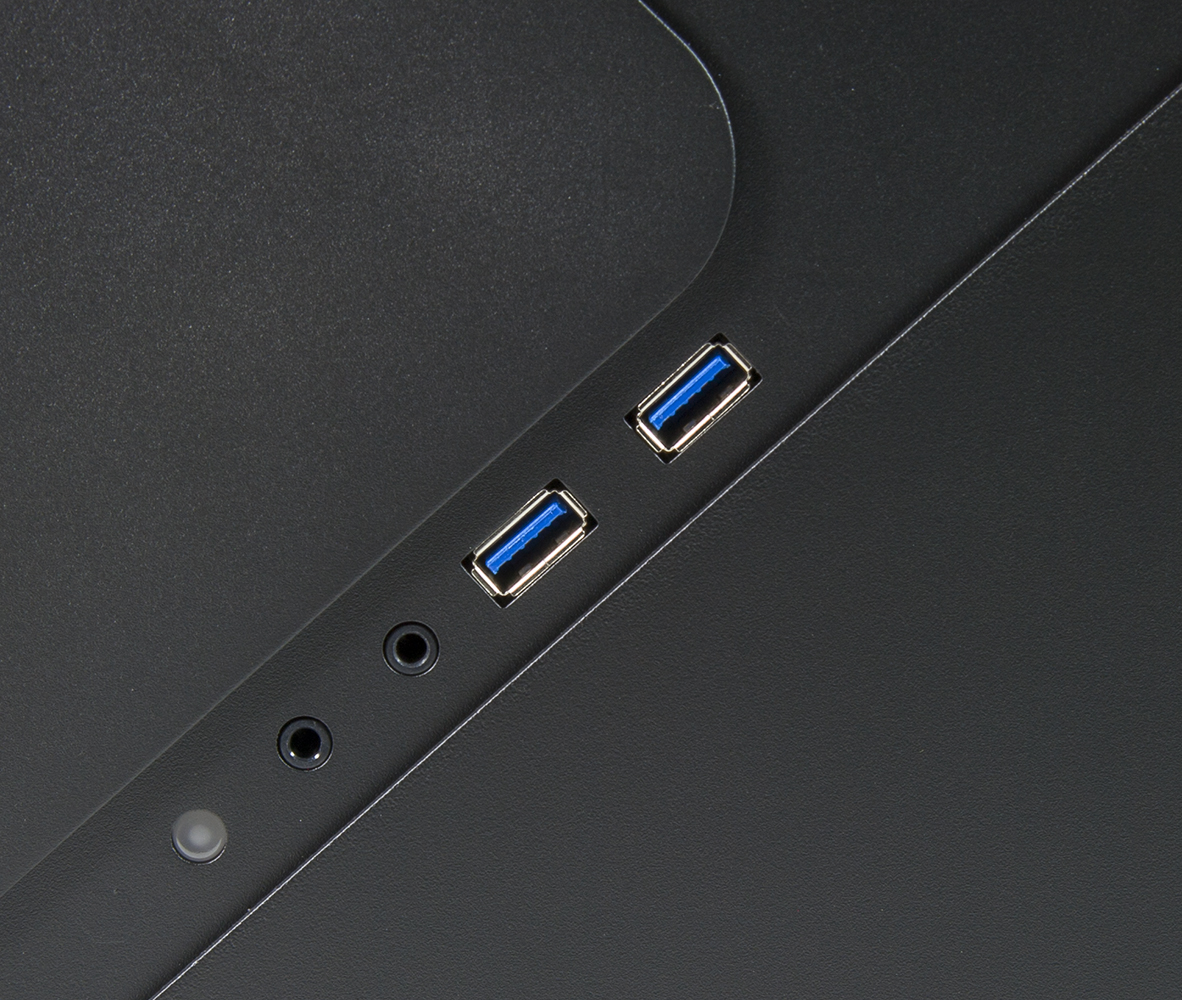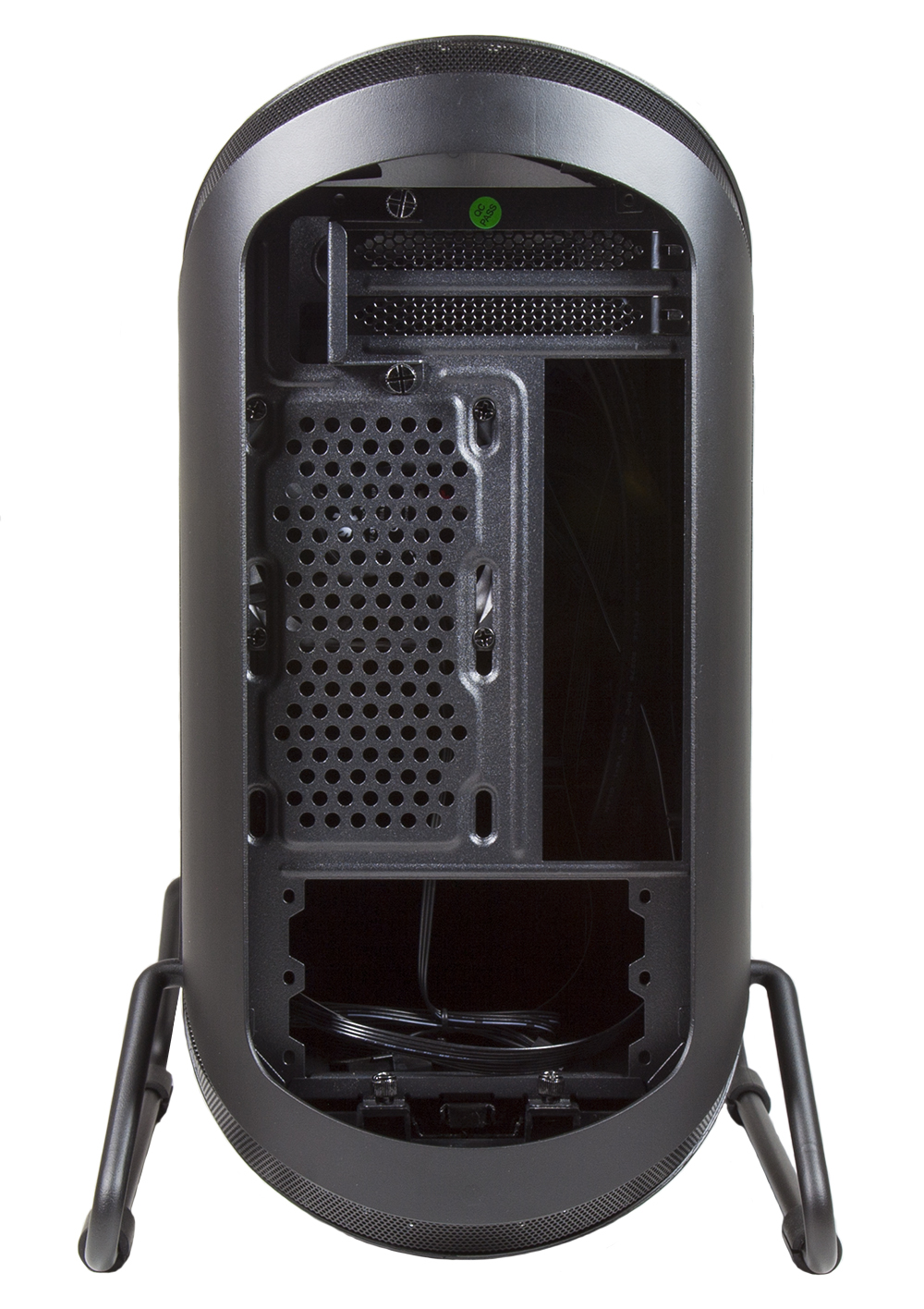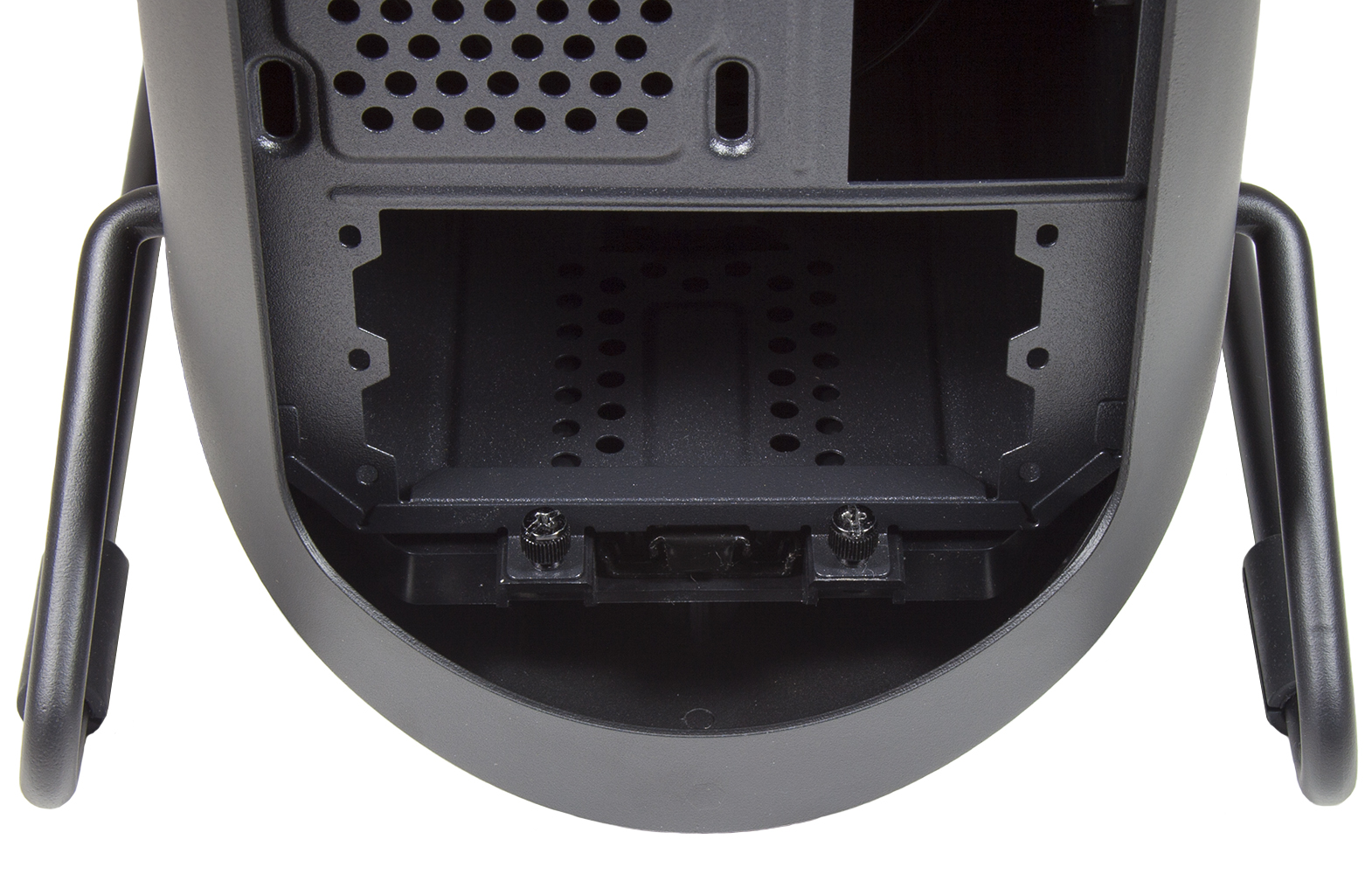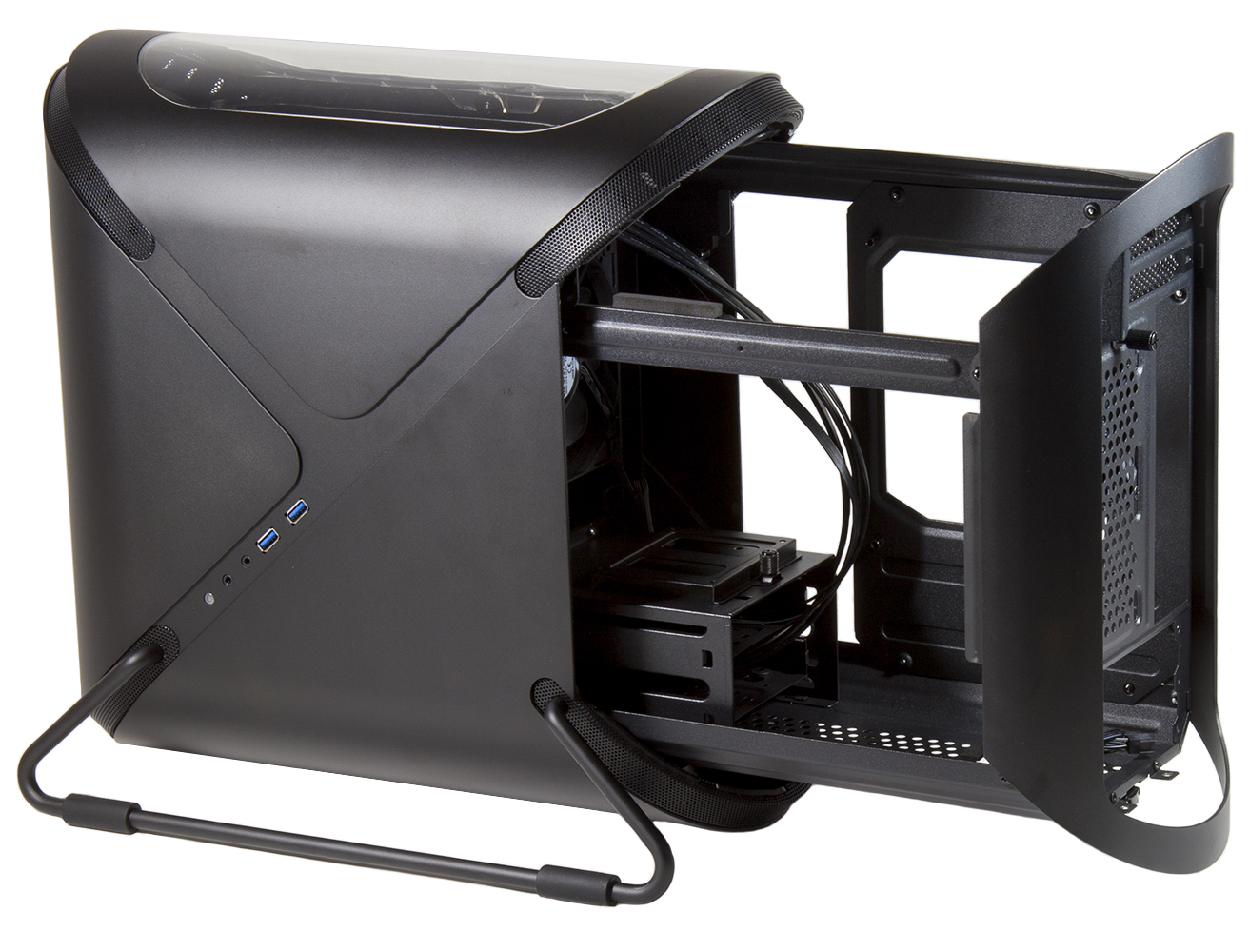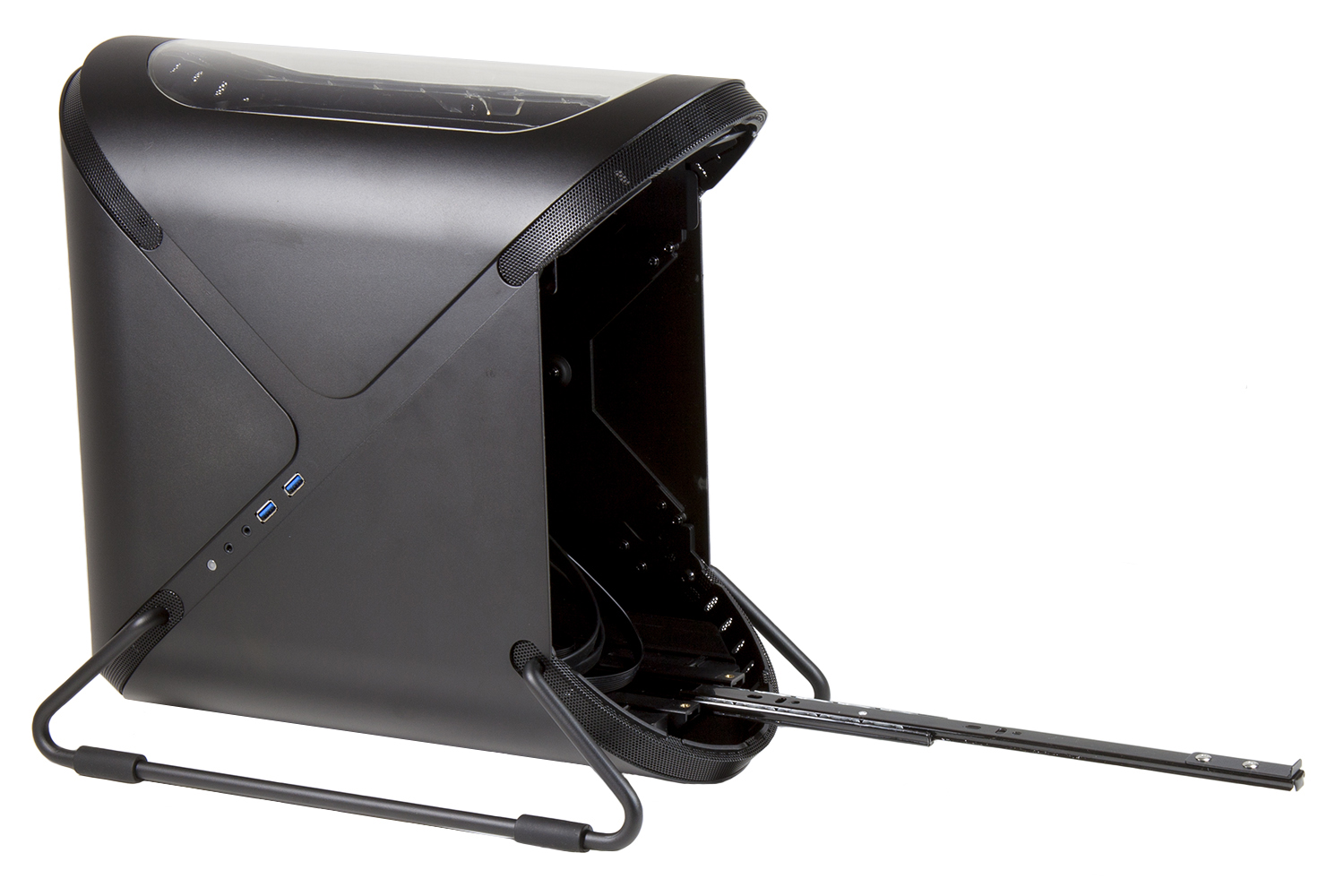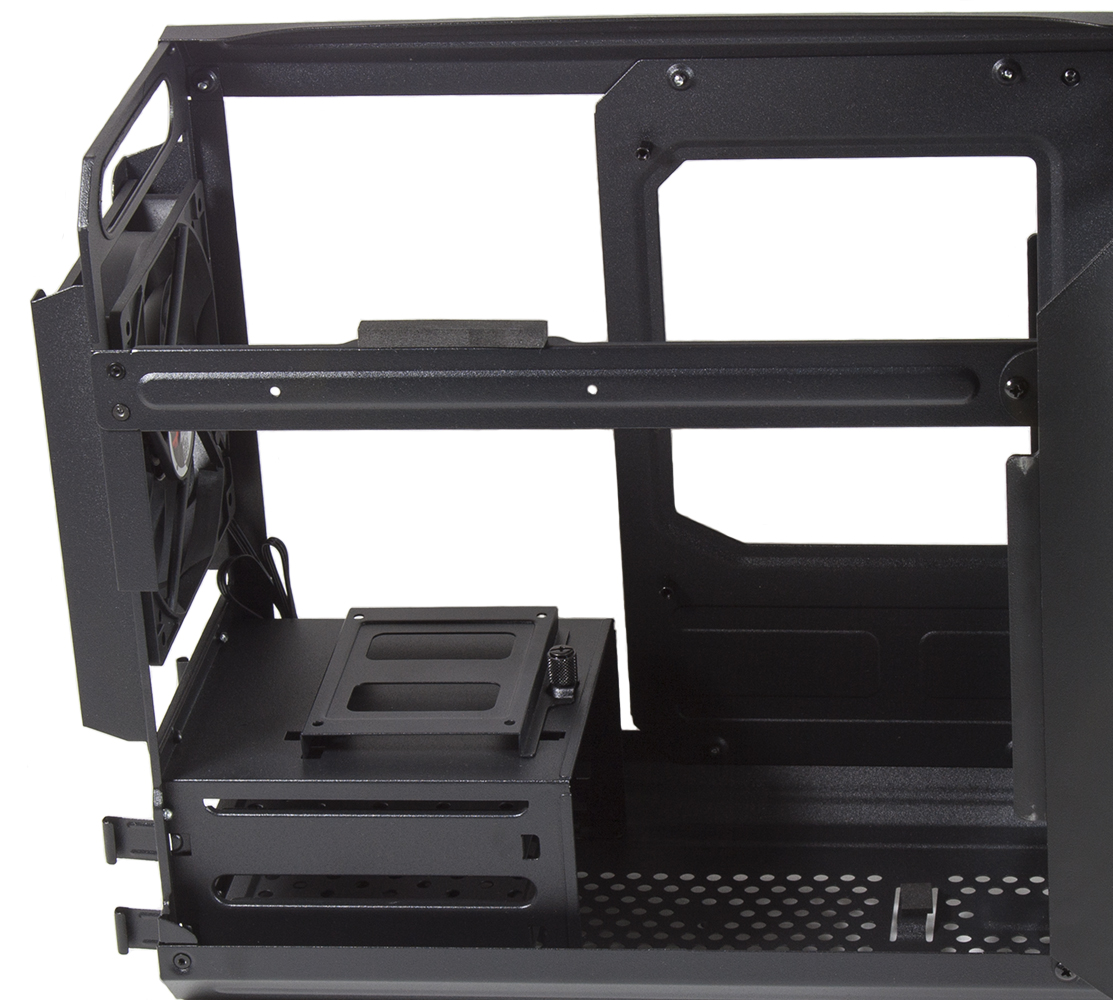Early Verdict
The Portal’s relatively uncommon and functional design combined with its smooth curves and finish, make it a good HTPC case for those willing to pay a premium.
Pros
- +
Aluminum construction
- +
Good form and finish
- +
Relatively unique design
Cons
- -
Price
- -
Poor airflow / Heat buildup
Why you can trust Tom's Hardware
Introducing the Bitfenix Portal
*Without Stand
**Each 3.5" Drive slot can hold an additional 2.5" drive
Fresh off the drawing board, Bitfenix’s latest case—Portal—looks to bring all the benefits of a tower case to the HTPC market, without the brick-like look that usually accompanies such a form factor. With its smooth curves and clean cut lines, we’d say that the Portal does a reasonable job achieving this goal and would probably blend in well enough in most environments, be it on a desk next to a monitor or sitting beside a TV in an entertainment center.
Although it's purpose built as an HTPC case, Bitfenix does go out of its way to mention that the Portal can also be used as a gaming case, with plenty of room to fit full size graphics cards and even a compact AIO cooler. With that in mind, can it still stand up to our gaming oriented test suite?
The Portal design is smooth, with not a single sharp corner to be found anywhere on the exterior. Up top you’ll find a clear acrylic window, which, when combined with the upside down orientation of the motherboard, offers up a view of your graphics card and a small glimpse of the rest of the case’s inner workings. If you’re seeking a more minimalist look, or if windows just aren’t your thing, the Portal is also available without a window. Furthermore, both versions of the case are also available in a white paint job if black also isn’t your thing. Finally, if you’re short on space, the stand is also removable, though we’re not sure what good that’ll do, considering the bottom of the case isn’t flat and it can’t stand up on its own.
Further examination of the case reveals a front mounted power button/power light, and for those who like their case next to a monitor on the left side of a desk, there's a set of I/O ports and hard drive activity light on the right. The I/O port offering on the Portal meets typical expectations for a Mini-ITX case, with a pair of USB 3.0 ports and the usual set of audio jacks.
On the rear of the case we find an upside down mounting configuration for the motherboard as well as a cutout for an SFX power supply. In the cooling department, there’s mounting room for one 80mm cooling fan. Yes, you read that right. Even though on first glance it looks like there might be room for an extra 80mm cooling fan below the first one, there actually isn’t quite enough room. In what seems to be odd design choice, the second pair of holes on bottom and the extra space seem to be for nothing more than extra room for airflow and perhaps an alternate mounting position for the included exhaust fan.
Get Tom's Hardware's best news and in-depth reviews, straight to your inbox.
By now, some of you have probably noticed that there doesn’t seem to be any obvious way of accessing the inside of the case for hardware installation. As it turns out, the pair of thumbscrews at the bottom of the case happen to hold the answer.
In an interesting bit of engineering, Bitfenix has chosen an unusual way of letting you access the inside of the case without the use of removable side panels. After removing the pair of thumbscrews you see in the previous photo, the entire back end of the Portal, along with the internal structure, slides out of the back of the case along a built-in rail. Though slide-out motherboard trays used to be "the thing" back in the early 2000s, they’ve almost completely faded away since then. Furthermore, in almost all of the old case designs, it was usually only the motherboard tray and back panel that slid out, whereas here literally everything inside the case comes out as one complete unit.
For those who may be curious, here’s a shot of the case once the slide out portion has been fully removed.
Examining the case’s internal structure reveals a generous cutout in the motherboard tray as well as a removable bracket for mounting 2.5” hard drives/SSDs.
Meanwhile, the front reveals two removable 3.5” hard drive trays, which may be used to mount 2.5” drives and also include rubber spacers to help isolate mechanical drive vibration. As an extra bonus it’s worth noting that unlike some other cases, the drive holders in the Portal are made of metal and are not prone to having the front clips fail like their cheaper plastic counterparts.
Finally, there’s also a mounting bracket for a 120mm cooling fan, or a 120mm AIO cooler, which we'd recommend if you’re going to use this as a gaming case.
MORE: Best Cases
MORE: All Case Content
MORE: In Pictures: 40 Unusual Computer Case Mods
- 1
- 2
Current page: Introducing the Bitfenix Portal
Next Page Hardware Installation, Evaluation, And Final Analysis-
Johan Kryger Haglert That was one ugly case.Reply
Is it supposed to look like the auto-turrets?
Looks like something which could a case for a future Amiga when we had the Amiga Walker case:
http://pre12.deviantart.net/f643/th/pre/f/2014/040/3/f/remake_of_the_amiga_walker_prototype_ad_by_zgodzinski-d75qfyz.jpg
http://www.blachford.info/computer/walker/front_page/S_Walker.jpg
Maybe even the Amiga MMC:
http://www.vincentperkins.com/AmigaNG/images/MCC/amcc13.jpg
http://web.tiscali.it/amigabrain/Redazione/amigaMCC.jpg :(:(:(
So ugly. Why did this make it into a real product? -
Rusticovertones I completely disagree with everything you just posted Johan. It might not be for everyone, but what is? It made it as a real product because there are people who will buy it. I Already ordered one. Love the unique design, love the layout and pull out frame. It's rare we see anything but a box frame for custom builds.Reply
Can't wait to build in it. -
Kunra Zether I'm not really liking this design. I see alot of air flow restriction. I hope you could fit some aio coolers in this because I don't see how you can expect to get all that hot air out with the lack of venting and just one 80mm exhaust fan. There should be vent slots along the sides of the case to help the hot air get out. I do like the railing system, makes the build so much easier in cases like this. What I don't understand is what this case is being marketed for. It's too bulky and obtrusive imo to be used as an htpc in your living room. I mean if I want something for the living room I want it to be able to blend in.. it would be better if you could lay it flat and slide it into your entertainment center... Even if you could thoughs USBs on the side would make it real fun to have to keep sliding it in and out to plug in device even if the could fit. As for using it as a desktop PC I just don't see the point unless you just like the uniqueness of it's looks I suppose. I'm more partial to excution then to form and I feel that there are cases that sell for much cheaper and preform alot better and also lend themselves to customization as a bonus. It also doesn't seem very portable either; at least not without having to put it in some type of carrying case or something so it doesn't fall over.Reply
Imo if a case breaks the $75 mark because there are alot of great cases under that line it better be bringing something truly special that makes me say wow to earn that price.
I would personally like to see more cases being designed for gaming in the living room on the big screen because I feel that this is a part of the market that's just going to keep growing. -
ubercake I like this case. It would be better if the stand didn't extend the width of the case to mini-tower proportions.Reply
Looking at the temps in the review, I would not build a system with this case where I would want to experiment with overclocking (I really don't think that's the intent of the mini-ITX platform). This is for a straight-up stock build. -
dstarr3 I'm going to have to agree that this case is pretty ugly. I appreciate that they want to make rounder cases, because the PC case market is full of many, many box-shapes, but... well, just being round doesn't propel this up above the better-looking boxes.Reply -
gotzutech It's realy nice device..it's real product beacause there are people who will buy it..Reply -
Kunra Zether I like how people downvote comments up hear without even giving a reply as to why they disagree with said comment...Reply
Ubercake my Cooler Master elite 130 mini ITX case begs to differ with mini-itx lending it's self to OC. Got an I5 6500 oc through blck to 4.0 atm can push it to 4.5 if I wanted utilizing my H60 in it's push/pull configuration. Got a GTX 1070 Asus strixs oc to boot. If there's a will there's a way. If gamer can oc.. were gonna oc -
palladin9479 I like the concept and the look would go well in my own Home Theater environment. I use a lot of black metal and glass for a modern look and this would fit perfectly with that.Reply
Also a note about HTPC's, the vast majority of people doing them aren't playing heavy games on them nor are overclocking nor care about "performance". HTPC's are primary about aesthetics and noise control because the environment they exist in, the living room / entertainment / media room, is an environment meant to entertain guests or escape reality. Nothing breaks immersion more when your watching a film and hear your HTPC's fans spinning loudly to cool the overclocked components, or when your guests are sitting in the room having beers and they comment on why there is a loud whining sound in the background.
The 1070 seems extremely overkill in a HTPC, something like a 1050Ti would be more then enough. Hell my HTPC is using the AMD A8-7650K with DDR3-2133 and it's great for what its meant to do. High end gaming is done in the computer room where my beast lives, not in the media room.
Here is what I'm currently using
https://www.newegg.com/Product/Product.aspx?Item=9SIA2F84D68845
This is their newer version, extremely small but looks great.
https://www.newegg.com/Product/Product.aspx?Item=N82E16811108485&cm_re=Chopin-_-11-108-485-_-Product
No way in hell your getting a dGPU into that case so definitely not a "gaming PC".

